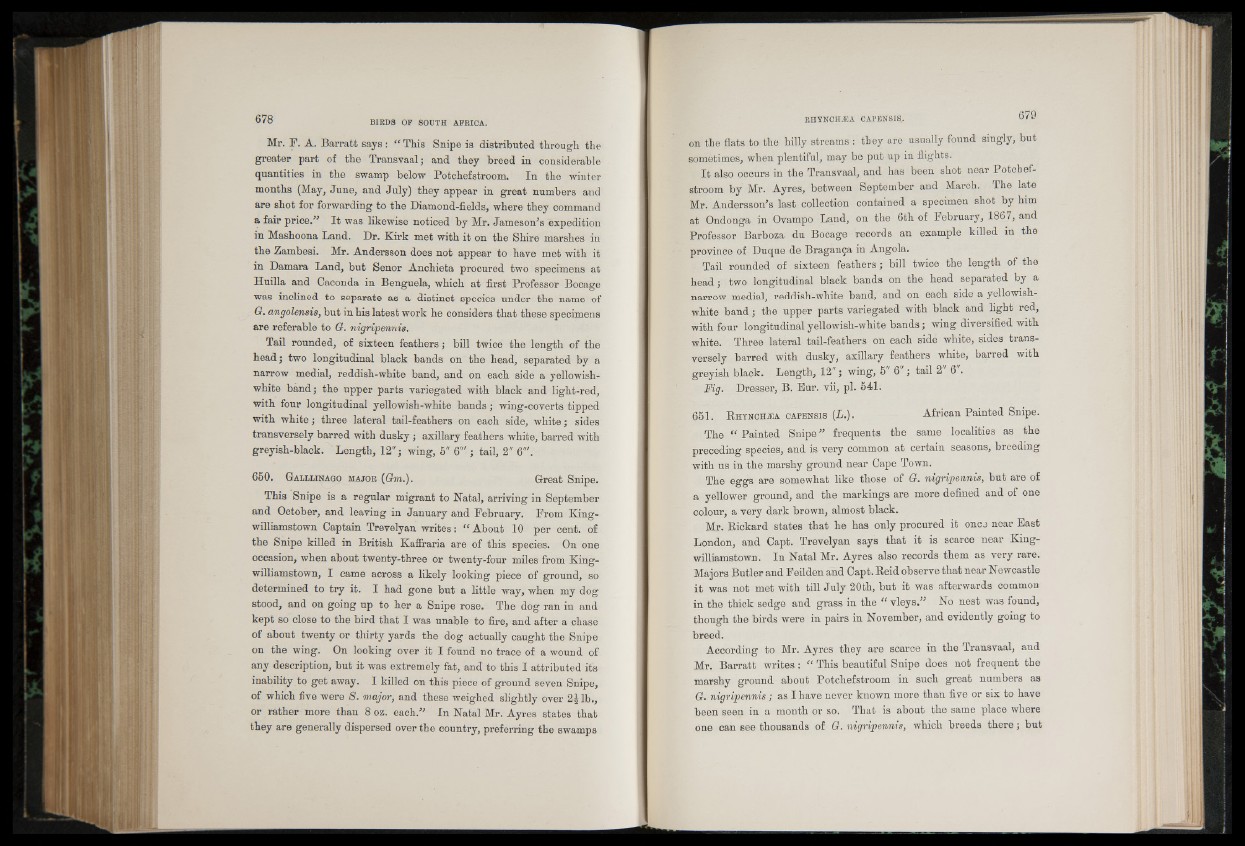
Mr. F. A. Barratt says: “ This Snipe is distributed through the
greater part of the Transvaal; and they breed in considerable
quantities in the swamp below Potchefstroom. In the winter
months (May, June, and July) they appear in great numbers and
are shot for forwarding to the Diamond-fields, where they command
a fair price.” It was likewise noticed by Mr. Jameson’s expedition
in Mashoona Land. Dr. Kirk met with it on the Shire marshes in
the Zambesi. Mr. Andersson does not appear to have met with it
in Damara Land, but Senor Anchieta procured two specimens at
Huilla and Caconda in Benguela, which at first Professor Bocage
was inclined to separate as a distinct species under the name of
G. angolensis, but in his latest work he considers that these specimens
are referable to G. nigripennis.
Tail rounded, of sixteen feathers; bill twice the length of the
head; two longitudinal black bands on the head, separated by a
narrow medial, reddish-white band, and on each side a yellowish-
white band; the upper parts variegated with black and light-red,
with four longitudinal yellowish-white bands; wing-coverts tipped
with white; three lateral tail-feathers on each side, white; sides
transversely barred with dusky ; axillary feathers white, barred with
greyish-black. Length, 12"; wing, 5" 6'" ; tail, 2" 6'".
650. Galllinago major (Gm.). Great Snipe.
This Snipe is a regular migrant to Natal, arriving in September
and October, and leaving in January and February. From King-
williamstown Captain Trevelyan writes: “ About 10 per cent, of
the Snipe killed in British Kaflraria are of this species. On one
occasion, when about twenty-three or twenty-four miles from King-
williamstown, I came across a likely looking piece of ground, so
determined to try it. I had gone but a little way, when my dog
stood, and on going up to her a Snipe rose. The dog ran in and
kept so close to the bird that I was unable to fire, and after a chase
o f about twenty or thirty yards the dog actually caught the Snipe
on the wing. On looking over it I found no trace of a wound of
any description, but it was extremely fat, and to this I attributed its
inability to get away. I killed on this piece of ground seven Snipe,
o f which five were S. major, and these weighed slightly over 2 | lb.,
or rather more than 8 oz. each.” In Natal Mr. Ayres states that
they are generally dispersed over the country, preferring the swamps
on the flats to the hilly streams : they are usually found singly, but
sometimes, when plentiful, may be put up in flights.
It also occurs in the Transvaal, and has been shot near Potchefstroom
by Mr. Ayres, between September and March. The late
Mr. Andersson’s last collection contained a specimen shot by him
at Ondonga in Ovampo Land, on the 6th of February, 1867, and
Professor Barboza du Bocage records an example killed in the
province of Duque de Bragan§a in Angola.
Tail rounded of sixteen feathers; bill twice the length of the
head; two longitudinal black bands on the head separated by a
narrow medial, reddish-white band, and on each side a yellowish-
white band; the upper parts variegated with black and light red,
with four longitudinal yellowish-white bands; wing diversified with
white. Three lateral tail-feathers on each side white, sides transversely
barred with dusky, axillary feathers white, barred with
greyish black. Length, 12"; wing, 5' 6 ; tail 2 6 .
Fig. Dresser, B. Bur. vii, pi. 541.
651. R h y n c m ia c a pens is (L.). African Painted Snipe.
The “ Painted Snipe” frequents the same localities as the
preceding species, and is very common at certain seasons, breeding
with us in the marshy ground near Cape Town.
The eggs are somewhat like those of G. nigrvpennis, but are of
a yellower ground, and the markings are more defined and of one
colour, a very dark brown, almost black.
Mr. Rickard states that he has only procured it once near Bast
London, and Capt. Trevelyan says that it is scarce near King-
williamstown. In Natal Mr. Ayres also records them as very rare.
Majors Butler and Feilden and Capt. Reid observe that near Newcastle
it was not met with till July 20th, but it was afterwards common
in the thick sedge and grass in the “ vleys.” No nest was found,
though the birds were in pairs in November, and evidently going to
breed.
According to Mr. Ayres they are scarce in the Transvaal, and
Mr. Barratt writes : “ This beautiful Snipe does not frequent the
marshy ground about Potchefstroom in such great numbers as
G. nigripennis ; as I have never known more than five or six to have
been seen in a month or so. That is about the same place where
one can see thousands of G. nigrvpennis, which breeds there; but